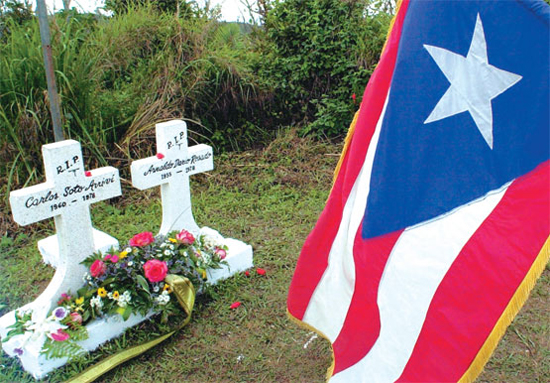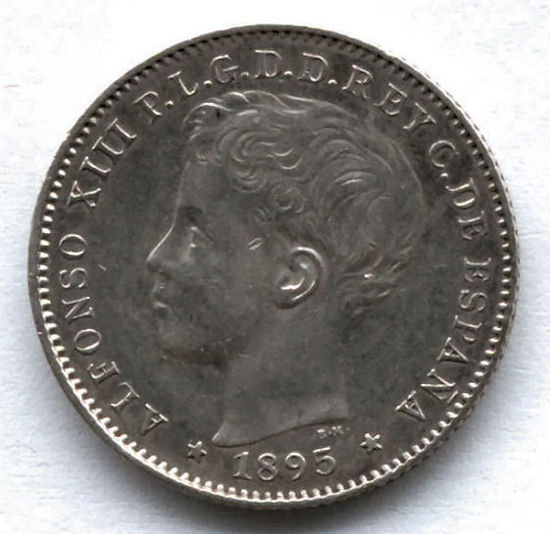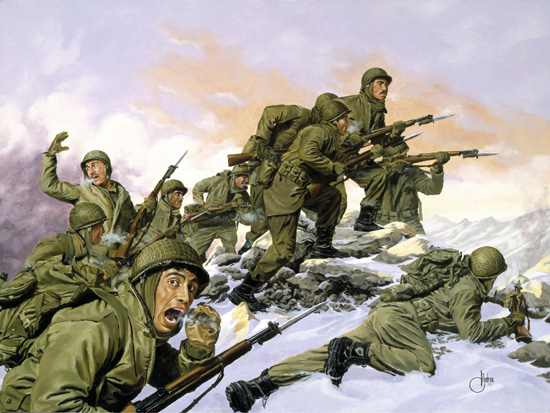
Villalba, Julio 25, 2000. En la foto, una bandera puertorriquena hodea frente a las cruces de los martires Carlos Soto Arrivi y Arnaldo Dario Rosado en el Cerro Maravilla.
This article is about the killings that occurred on the mountain in 1978.
The Cerro Maravilla Incident, also known as the Cerro Maravilla Case or the Cerro Maravilla Killings is the name given by the Puerto Rican public and media to describe the events that occurred on July 25, 1978 at Cerro Maravilla, a mountain in Puerto Rico, where in two young Puerto Rican pro-independence activists were killed in a police ambush. The event sparked a series of political controversies where, in the end, the police officers were found guilty of murder and several high-ranking local government officials were accused of planning and or covering-up the incident.
Originally declared a police intervention against terrorists, the local media quickly questioned the officers’ testimonies as well as the only surviving witness for inconsistencies. Although reluctant, the Governor of Puerto Rico at the time Carlos Romero Barceló ordered the local Justice Department to launch various investigations, and asked the FBI and the US Justice Department to aid in such investigations, which concluded that there was no wrong doing on the officer’s part. However, after the local opposing political party launched its own investigations, new evidence and witness testimonies uncovered gross negligence on the officers’ part, as well as the possibility of a local and federal cover-up. Local trials were held, and a total of 10 officers were convicted of various crimes.
The incident and subsequent events have become one of the most controversial moments in Puerto Rico’s political history. The event is often referred to by local independence activists as an example of political oppression against the Puerto Rican independence movement. On the night of July 25, 1978 Carlos Soto Arrivi and Arnaldo Dario Rosado, two independence activists of the Armed Revolutionary Movement along with undercover police officer Alejandro Gonzalez Malavé posing as a fellow group member, took taxi driver Julio Ortiz Molina hostage and ordered him to drive them to Cerro Maravilla where several communication towers were located. Their original plan was to set fire and sabotage the towers to protest the imprisonment of Puerto Rican nationalists convicted of the 1950 assassination attempt on U.S. President Harry S. Truman and the 1954 shooting at the United States Capitol where five members of Congress were injured. State police officers were alerted of their plan prior to their arrival and the activists were ambushed and shot. The undercover agent received a minor bullet wound during the shooting, while the taxi driver was left unharmed.
The morning after the shootings, the officers argued that they acted in self defense, stating that they ordered the activists to surrender, at which time the activists started shooting at them and they returned fire. Initially, the taxi driver said he was under the dashboard of his cab when the shooting started and could not see who shot first, although he contradicted his statement a few days later in an interview with the San Juan Star, a local newspaper, stating that he ducked under the dashboard of the car after the three men (the two activists and the undercover agent) left the car, and that he saw “10 heavily armed men” approaching. When he emerged from the car, he saw the three men alive and two of them were being beaten by the armed men, who were later identified as policemen.
The first investigations
Then-Governor of Puerto Rico Carlos Romero Barceló (PNP) praised the officers in a televised address by calling them heroic, stating that they acted in self-defense and stopped a terrorist attack. However, facing public pressure due to the taxi driver’s conflicting statements, the Governor ordered two separate investigations by the P.R. Justice Department in addition to the ongoing standard Police investigation, all of which concluded that the officers’ actions were free of any wrongdoing, despite various inconsistencies in their stories. Opposing political parties, mainly the Popular Democratic Party (PDP), insisted that the investigations were just cover-ups and demanded that a special independent prosecutor be assigned to investigate. Two special investigations by the U.S. Justice Department’s Civil Rights Division and by the U.S. Federal Bureau of Investigation (FBI) were performed on separate occasions between 1978 and 1980, which confirmed the conclusions of the P.R. Justice Department that the officers acted in self-defense.
The second investigations
In the November 1980 general elections, Governor Romero Barceló was re-elected by a margin of 3,503 votes (one of the closest in Puerto Rico history), though his party lost control of the state legislature to the main opposing party, the PPD. This loss was attributed by the New York Times to the surrounding controversy regarding the investigations at the time, however other news organizations, such as Time Magazine, attributed the loss to Gov. Romero Barceló’s stance on the island’s political status. The Legislature quickly started new inquiries and hearings into the Cerro Maravilla incident. The Senate, then presided by Miguel Hernandez Agosto, spearheaded the investigations by naming former Assistant District Attorney Hector Rivera Cruz to investigate.
The second investigations performed between 1981 and 1984 by the legislature, the U.S. Justice Department, and the local press uncovered a plot to assassinate the activists and a possible, though not conclusive, conspiracy to cover-up these actions. During interviews of the Senate Investigations Committee in 1983, officer Miguel Cartagena Flores, a detective in the Intelligence Division of the Puerto Rico Police Department, testified: When I arrived at the scene I saw 4 police officers aiming their guns at the two activists who were kneeling before them. I turned my eyes away and heard 5 gunshots”. Cartagena, who was offered immunity for his testimony, would add that several hours before the shooting, he and other officers were told by Col. Angel Perez Casillas, commander of the Intelligence Division, that these terrorists should not come down (from the mountain) alive. His testimony was corroborated by officer Carmelo Cruz who, although he did not witness the fatal shooting, confirmed many details provided by Cartagena when also granted immunity.
Other inquiries obtained similar testimony from witnesses, including the taxi driver who now stated that the activists were alive and disarmed when the police removed him from the scene. The taxi driver stated that there was a short exchange of gunfire, and when he was removed to another place nearby he heard a second volley of gunfire, but was asked by the police and investigators of the PR Justice Department to forget about the second round of shots. The statement regarding two different volleys of shots was upheld by various people, including ex-officer Jesus Quiñones before a Federal grand jury (he quit the force shortly after the shootings), and three other civilian witnesses in a San Juan Star interview.
Subsequently, the legislature and local press started questioning the P.R. Police Department’s, the P.R. Justice Department’s, the U.S. Justice Department’s, and the FBI’s actions during the first investigations, alleging corruption within the agencies and a conspiracy to cover-up evidence. Letters were sent by various community and political leaders to then Senate Judiciary Committee chairman Senator Edward M. Kennedy, asking for an inquiry into the conduct of the Federal investigations. Several letters even accused former US Attorney General Benjamin R. Civiletti of providing aid to Gov. Romero Barceló during the investigations. Two leaders from the opposing parties, the Popular Democratic Party and the Puerto Rican Independence Party, charged that after a December 1979 meeting between the two, the Governor, then considered as a lifelong Republican, began campaigning to deliver the 41 Democratic Party convention votes of the island for President Jimmy Carter’s (D) nomination for the presidency (ironically, Carter’s opponent for the nomination was Senator Kennedy). Almost 45 days after President Carter won the nomination by 1 delegate, the U.S. Justice Department announced that, for lack of evidence, it was concluding its investigation. A Justice Department internal memorandum that was issued the same month of Romero Barceló’s and Civiletti’s meeting would later prove that the investigations were closed even when agents were still investigating important evidence of the case which would potentially incriminate the officers, including several unexplained contusions on a victim’s face and the fact that one of the police officers recanted his original story, stating that there was in fact two bursts of firings.

These, and several other accusations, brought public and political pressure to all investigating agencies, which in turn led to internal revisions of evidence and procedures from the first investigations both at the local and federal level, although all organizations would still adamantly deny any cover-up conspiracy. These second investigations led to reassignments, demotions and resignations among top officials within the PR Justice Department, including 3 different P.R. Secretaries of Justice (equivalent to state Attorney General) accepting and resigning their posts in a span of six months. On November 29, 1983, three prosecutors were relieved of their duties after a report by the state Senate Investigations Committee found they had failed to properly investigate the Cerro Maravilla shootings, citing 101 specific deficiencies in two investigations. This was the third state Attorney General to oversee the investigations since the shootings occurred on 1978.
Aftermath
The second investigations led to 10 officers being indicted and found guilty of perjury, destruction of evidence, and obstruction of justice, of which 4 were convicted of second-degree murder during 1984. The convicted officers, which were not on active duty at the time due to various reasons, were:
- Col. Angel Perez Casillas (head of the PR Police Department’s Intelligence Division during the incident; suspended)
- Lieut. Nelson Gonzalez Perez (resigned),
- Lieut. Jaime Quiles Hernandez (suspended),
- Officer Juan Bruno Gonzalez (suspended),
- Officer William Colon Berrios (suspended),
- Officer Nazario Mateo Espada (suspended),
- Officer Rafael Moreno Morales (suspended),
- Officer Luis Reveron Martinez (on disability leave),
- Officer Jose Rios Polanco (suspended), and
- Officer Rafael Torres Marrero (on disability leave).
That same year, in the general elections held in November, Romero Barcelo lost his gubernatorial seat against former governor and opposing party rival Rafael Hernandez Colon (PPD). It is widely accepted that Romero Barcelo lost the elections because of this case, since his public opinion rating had deteriorated substantially during late 1984 as the investigations progressed, and since his political rivals used his defense of the officers as an indication of a possible conspiracy.
Undercover agent murdered
Alejandro Gonzalez Malave, the undercover agent who was accompanying the activists, was not indicted for his part in the slayings because he was granted immunity for testifying against other officers, but was removed from the police force due to public pressure. In February 1986, he was acquitted of kidnapping the taxi driver. His lawyer had argued that he was acting under orders and, therefore, it was the government who was actually guilty of kidnapping, even though testimony from officer Carmelo Cruz testified that it was Gonzalez Malave who recklessly endangered the hostage’s life. The prosecution had provided evidence that he threatened the hostage at gunpoint, drove the car, and, when the car approached the mountaintop, refused to free the hostage despite suggestions from the activists. These actions, according to officer Cruz, were contrary to standard police procedures since his primary concern should have been the safety of the hostage. Nevertheless, the PR Police Department did not reinstate Gonzalez as an active police officer, a fact that he publicly expressed resentment over, and subsequently threatened to provide incriminating evidence to the media about other individuals involved in the shootings unless reinstated.
On the evening of April 29, 1986, just two months after his acquittal, Gonzalez Malave was assassinated in front of his mother’s house in Bayamon. He received three gunshot wounds while his mother was slightly injured. A few hours later, a group identifying itself as the Volunteer Organization for the Revolution called local news agencies claiming responsibility. In their statements they swore to kill, “one by one”, all the policemen involved in the deaths in Cerro Maravilla. The FBI considered it one of the most dangerous terrorist organizations in the United States at the time, given that it was the same organization that claimed responsibility for an attack on a Navy bus in Puerto Rico on December 3, 1979 where two Navy men were killed and 10 people injured, as well as an attack on a U.S. National Guard base on January 12, 1981 where six fighter-jet planes were destroyed. To this day, no one has been identified as a possible suspect in Gonzalez Malave’s murder, and the case remains unsolved.
Public apologies
In 1992, former US Justice Department Civil Rights Division chief Drew S. Days III admitted before the P.R. Senate that the U.S. Justice Department and the FBI acted negligently during the 1978-1980 investigations of the Cerro Maravilla incident, such as rejecting interviews with key witnesses (including the taxi driver), refusing to offer immunity to certain witnesses, and avoiding various standard investigating tasks. Days stated: “I think that certainly an apology is justified with respect to the way the federal government handled its investigation: the FBI, the Justice Department, and my division . . . it was not done in the professional way that it should have been done. FBI Director William S. Sessions had made similar concessions in a written statement in 1990, stating: In hindsight, the eyewitness should have been interviewed and a civil rights investigation initiated. In 1984, the FBI conducted an internal review of its Cerro Maravilla Case files, and concluded that there was no cover-up effort inside the FBI, only a desire to avoid derailing the cooperative anti-terrorism effort with the Puerto Rican police. Their statements were accompanied with promises to improve their agencies in order to avoid similar incidents in the future.
In 2003, 25 years after the incident, former Gov. Romero Barcelo admitted in a public radio interview that it was an error of judgment and a premature declaration to laud the police officers, since at that time he believed they were telling the truth about their self-defense. However, he has publicly denied any wrong doing regarding the alleged cover-up during the first investigations.
Legacy
Ever since the final investigations ceased, there has been a much heated debate about the Cerro Maravilla incident within Puerto Rico, with some groups arguing that there are still others responsible for planning and/or ordering the plot to kill the activists as well as the subsequent cover-up, while others have argued that the incident was exaggerated by rival politicians and the media, maintaining that no conspiracy was ever present and that some of the officers incarcerated, though not all, are actually innocent.
Every July 25, Puerto Rican nationalists and independence activists gather on Cerro Maravilla to honor Carlos Soto and Arnaldo Dario, as well as to defend and celebrate the Puerto Rican independence movement. It is usually organized by the family of the victims, former members of nationalist groups, and by the Puerto Rican Independence Party (PIP). The mountain has also been christened by them as El Cerro de los Martires (The Mountain of the Martyrs). The movie A Show of Force is based on the events and theories behind the incident.
From Wikipedia, the free encyclopedia




